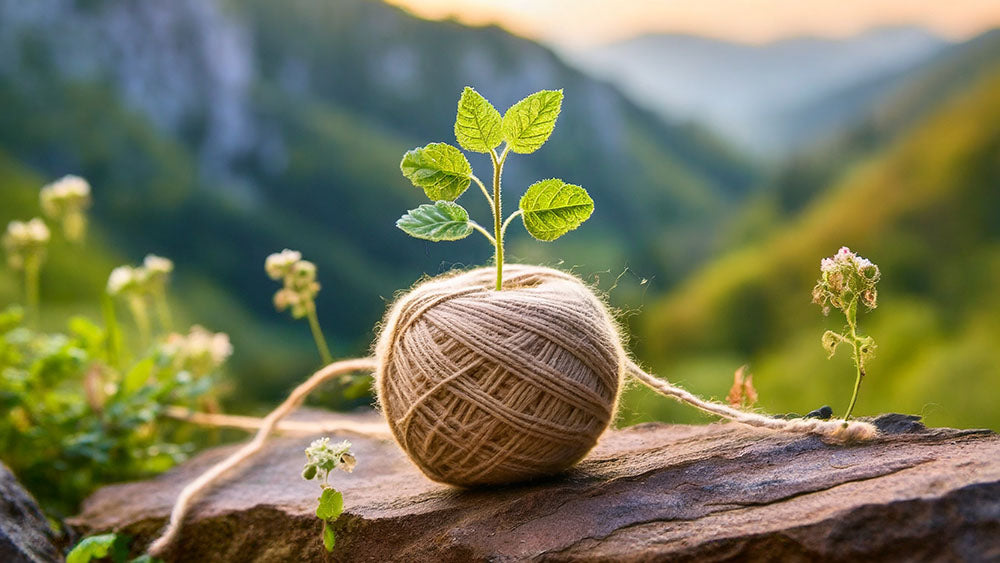Sustainable yarns and eco-friendly knitting
Crafters and yarn enthusiasts tend to be inherently environmentally friendly. Not only as we broadly share a ‘make do and mend’ mindset, but that making something lovely from scratch with natural fibres and quality materials, is keeping alive traditional methods and learning to make the best use and re-use of materials. Crafting then is most definitely an excellent start to being ‘eco-friendly’ (of which more later) though unfortunately not what is meant by ‘sustainable’.
Is wool sustainable or not?
Sheep farming and knitting is surely a clear example of something that has gone on successfully for millennia and therefore must be sustainable? The answer quickly becomes complex.
All agricultural production that has become industrialised, as in; operates at a global scale and uses large-scale mechanised methods of mass production has a detrimental effect on the environment and many argue this cannot continue in perpetuity.
Sheep farming especially on large scale for meat, wool for carpets and furniture and ‘fast fashion’ is driven by profit. Sheep prices fluctuate and have been going down for many years. Critics of farming animals say that sheep can get treated badly, are bred to produce as much wool as possible, and are often held in poor conditions. This is not the case for all large-scale sheep production and is strongly refuted by British, Australian and New Zealand Wool boards who go to great lengths to manage the industry and ensure the methods are humane.
https://www.britishwool.org.uk/animal-welfare-resources
In the UK, the smaller and more specialised the wool production, the more the animal husbandry improves and the chance to improve the concept of sustainability. Campaigns for increased awareness of farming practices have undoubtedly helped champion ecologically sound means of production, resulting in natural fibres from select breeds growing in popularity.
In simple terms then, surely the term ‘sustainable’ must refer to maintaining the source of the material we consume and managing its disposal. Throughout the life of that material, it should not pollute or disrupt, the environment.
Like a lot of ‘big questions’, attempts to define sustainability are in danger of being consumed and overused by the industries that use these terms and they can become Orwellian ‘Newspeak’. Bland, meaningless, and ultimately confusing the issue.
Kate Fletcher. Professor of sustainability and fashion and author of many books the subject, provides a set of statements which are good starting point.
Q: What is your definition of fashion sustainability?
KF: Fashion that fosters ecological integrity and social quality through products, practices of use and relationships.
KF: A more authentic, flexible and interconnected view of fashion, people and the world.
KF: fashion that helps us engage, connect and better understand ourselves, each other and our world.
KF: Fashion that engages with a process of flourishing of human and non-human species.
https://katefletcher.com/fashion-and-sustainability-faqs/
Can the individual make any real difference?
There is tension in the whole ‘eco-friendly’ debate around individual actions and their effectiveness compared to corporate ‘greenwashing’
If you are unfamiliar with the term, then ‘greenwashing’ is defined by the United Nations as:
By misleading the public to believe that a company or other entity is doing more to protect the environment than it is, greenwashing promotes false solutions to the climate crisis that distract from and delay concrete and credible action.
https://www.un.org/en/climatechange/science/climate-issues/greenwashing
The debate like so many of our current issues, is fractured and polarised. Finding a solid middle ground can be challenging.
The British Campaign for Wool makes the case for natural and sustainable fibre production, reducing plastic and nylon fibres and promotes another ‘buzz word’ which is ‘Circular Economy’
https://www.campaignforwool.org/whywoolmatters/
Wool is a natural fibre and is biodegradable, it can be reused and recycled and if produced and looked after with care can last a long time. It should be as far away from fast fashion as it gets. Unfortunately, its often treated as a throwaway. There are textile landfills around the world full of relatively high quality cashmeres and other natural fabrics which have been mass produced have become a by product of our global textile industry
Removing nylon and acrylics from yarns completely is challenging for the individual crafter. Elastane in sock wool for example is hugely helpful in increasing its wearability and durability. Individual choice is important and makes a difference in promoting to the industry what people want. The balance for the individual is in making the best use of materials and focussing on ways to manage our textiles. This could be investing in one or two lifetime pieces for our wardrobes, and understanding recycling and repurposing of textiles. Awareness of the lifecyle of a product is what the ‘circular economy’ is referring to.
https://www.commonobjective.co/how-co-works#sustainability-definitions-tab
This is a huge subject and one that I think Government and large global corporations should be held accountable for leading on. I recognise the need for individual change, but I still drive a diesel car, and an eco-warrior could undoubtedly point out how lacking my wardobe is in sustainable credentials. The goal of the shop is to develop as part of a circular economy a moving towards smaller independent brands that champion sustainability and the circular economy. Its an ongoing conversation I feel only at the start of.

